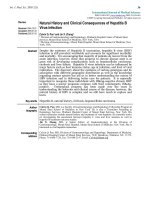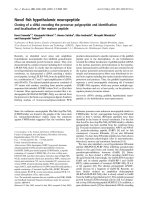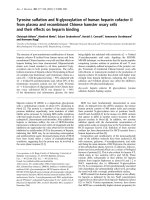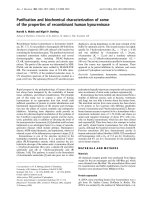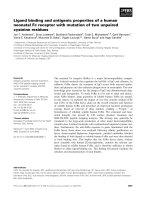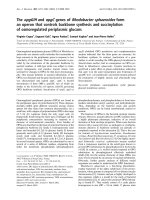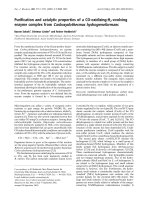Báo cáo y học: " Phosphatidylserine receptor and apoptosis: consequences of a non-ingested meal" pptx
Bạn đang xem bản rút gọn của tài liệu. Xem và tải ngay bản đầy đủ của tài liệu tại đây (46.07 KB, 4 trang )
147
PS = phosphatidylserine; PSR = phosphatidylserine receptor.
Available online />Introduction
Apoptosis is an active process of cell suicide that leads to
ordered destruction of the cells and their safe disposal by
professional (macrophages and immature dendritic cells)
and nonprofessional (such as fibroblasts and epithelial
cells) phagocytes [1]. The removal of apoptotic cells is the
final step and perhaps the ultimate objective of the
apoptotic programme. When apoptosis was initially
described by Kerr and coworkers [2], the phenomenon of
programmed cell death was greeted with a striking lack of
interest. It has now become apparent that the process is
ubiquitous and plays a key role in many fundamental
biological events, including embryonic development, normal
tissue homeostasis, development of the immune system and
resolution of inflammation. In addition, apoptotic cells are a
potential source of self-antigens [3], and defective
clearance of cell corpses has recently been implicated in
the pathogenesis of autoimmune diseases [4].
Although enormous progress has been made in our
understanding of the molecular mechanisms of apoptosis,
the events that lead to clearance of apoptotic cells are still
undefined. However, it has become increasingly clear that
in vivo apoptosis and engulfment are not distinct events,
but rather are two linked stages in the same process.
Cells dying by apoptosis provide both ‘recruitment’ and
‘eat me’ signals to scavenger cells, facilitating their own
uptake [5]. The best studied of these signals is exposure
of phosphatidylserine (PS), a phospholipid that is normally
limited to the inner leaflet of the plasma membrane bilayer.
Although it has been well established that PS exposure on
apoptotic cells is critically required for their proper uptake,
the identification of a single dominant receptor that is
capable of recognizing and removing the apoptotic cells
has remained controversial.
Is a phosphatidylserine-specific receptor
required for safe clearance of dying cells?
Many receptors and soluble ligands have been proposed
to mediate the recognition and uptake of apoptotic cells.
These include lectin-like molecules, scavenger receptors,
CD14, the thrombospondin receptor CD36, the vitronectin
receptor CD51/CD61, the oxidized low-density lipoprotein
receptor CD68, the low-density lipoprotein receptor
related protein (LRP1, known as CD91) and annexins [6].
Some receptors recognize apoptotic cells in the early
phase of cell death, whereas others, which recognize later
stages of the process, act as backup systems. Some
Commentary
Phosphatidylserine receptor and apoptosis: consequences of a
non-ingested meal
Marina Botto
Rheumatology Section, Eric Bywaters Centre, Faculty of Medicine, Imperial College, London, UK
Corresponding author: Marina Botto (e-mail: )
Received: 8 Mar 2004 Revisions requested: 5 Apr 2004 Revisions received: 19 Apr 2004 Accepted: 28 Apr 2004 Published: 4 Jun 2004
Arthritis Res Ther 2004, 6:147-150 (DOI 10.1186/ar1191)
© 2004 BioMed Central Ltd
Abstract
Apoptosis, a physiological process of controlled cell death, is essential during embryonic development
and for the maintenance of tissue homeostasis. In recent years the view has emerged that dying cells
can provide specific signals that enable recruitment and recognition by phagocytes. Exposure of
phosphatidylserine, the best characterized of such signals, allows safe clearance of apoptotic waste
without induction of inflammation. Here I re-examine some of the arguments that underpin the
importance of these clearance mechanisms in light of recent observations from an animal model that
lacks the receptor specific for phosphatidylserine.
Keywords: apoptosis, autoimmunity, inflammation, phagocytosis
148
Arthritis Research & Therapy Vol 6 No 4 Botto
recognition pathways distinguish between apoptosis,
necrosis and cellular debris, whereas others do not.
Consistent with the idea that apoptotic cell recognition/
engulfment may require a coordinated engagement of
multiple receptors, inhibition studies conducted in vitro
have failed to block phagocytosis completely, even when
inhibitory antibodies or ligands have been used in
combination. In addition, mice engineered to carry
deletions in any single one of these multiple receptors
exhibited no defective clearance or minor defects in
embryonic development. Thus, it has been suggested that
different phagocytic receptors may cooperate with each
other and function as a team. Some receptors may simply
play a role in tethering of phagocyte to apoptotic cells
without generating a signal, whereas others would engage
a signal pathway leading to cytoskeleton rearrangements
and engulfment. Many of the receptors implicated in the
recognition of apoptotic cells have been shown to bind PS
liposomes. However, strong evidence for an in vivo
stereo-specific recognition of PS exists only for the
phosphatidylserine receptor (PSR) [7], indicating that this
receptor may play a dominant role.
The PSR, which remained elusive for a long time because
of lack of specific reagents [7], was postulated to be a
prerequisite for uptake of apoptotic cells by macrophages
but in vivo evidence was lacking. Reassuringly, the
knockout model described in the paper by Li and
colleagues [8] provided such proof. The PSR-deficient
animals were found to be unable to breathe and died
within 24 hours of birth. Histological examination of the
lung revealed a severe reduction in the number of
airspaces formed and accumulation of noningested dying
cells, suggesting that PSR is crucial for clearing apoptotic
cells from the developing lungs. The role of PSR in this
process was also confirmed by in vitro phagocytic
experiments showing that the engulfment of apoptotic
cells by PSR-deficient macrophages was significantly
impaired and the defect was specific for PS liposomes. In
addition, a parallel study conducted by Wang and
coworkers [9], which demonstrated that psr-1, the
Caenorhabditis elegans homologue of PSR, is important
for cell corpse engulfment, provided further strong support
to the idea that this receptor plays a critical role in
recognizing PS during phagocytosis. Indeed, the
clearance defect in the psr-1 mutant was rescued by
overexpression of human PSR. Furthermore, in that study
the intracellular signalling pathways engaged by PSR-1 to
promote the cell corpse engulfment were also identified,
providing important clues regarding how the PSR may act
to transduce the engulfment signal in mammalian
phagocytes.
Although the in vivo observations reported by Li and
coworkers [8] would be consistent with the idea that
different tissues may use different clearance mechanisms,
the report did not provide a detailed examination of other
organs, apart from the malformations observed in the
brain. Hence, the potential role of PSR in embryogenesis
of other organs remains undefined. In this context it is of
note that Kunisaki and coworkers [10] recently generated
a second strain of PSR-deficient mice. They found that
although these animals died within 24 hours from birth
(like those generated by Li and coworkers [8]), they
exhibited severe defects in erythroid and T-lymphoid cell
differentiation. Nevertheless, in that second study the lung
tissue was not examined, and the abnormalities described
in erythropoiesis and T-lymphopoiesis might not have
caused the lethal phenotype. Interestingly, Kunisaki and
coworkers [10] also found that the lack of PSR caused
repression of apoptosis in several tissues, including the
foetal liver and thymus, whereas Li and colleagues [8]
observed hyperplastic brain malformations associated
with an increased number of noningested apoptotic bodies
in a small proportion of PSR-deficient mice (~15%).
Can these observations be reconciled with each other?
One could speculate that the PSR-mediated uptake of
dying cells may trigger feedback mechanisms in which
macrophages regulate the fate of developing cells, as
previously described in the worm [11–13] and in humans
[14], and these signals may be tissue specific.
Alternatively, the different abnormalities in the PSR-
deficient mice may be related to the loss of a still unknown
nonphagocytic function of the PSR. Further research will
be required to test these hypotheses.
Disposing of dying cell: a fine balance
between proinflammatory and
anti-inflammatory signals
Phagocytosis of apoptotic cells is known to be an anti-
inflammatory [15] and immunologically silent process [16].
Micropinocytosis of apoptotic bodies triggers the
production of transforming growth factor-β – a cytokine
that suppresses inflammatory processes – whereas the
release of granule enzymes and proinflammatory cytokines
is inhibited [15,17,18]. Strikingly, cross-linking the PSR or
adding apoptotic cells to the inflamed milieu can reverse
the inflammatory response induced by potent stimuli such
as lipopolysaccharide [7,19,20]. This would suggest that
the engagement of PSR, without the engulfment of dying
cells, can mediate this anti-inflammatory process and thus
the uptake process, and cytokine production may be
functionally separable [7]. In this context it is of note that
in the lung of the PSR-deficient animals there was
evidence of inflammation associated with cell necrosis.
This observation is consistent with the hypothesis that
when cells undergoing apoptosis are not properly cleared,
they may enter late stages of apoptosis and secondary
necrosis consecutively. The membranes of the dying cells
became leaky, and the usually anti-inflammatory clearance
149
Available online />becomes proinflammatory. However, Kunisaki and
coworkers [10] found no evidence of an inflammatory
response in thymus and foetal liver of the PSR-deficient
mice, perhaps reflecting the lack of an increased number
of apoptotic cells in these tissues. Currently, the signal
events following [15] PS recognition by PSR that would
induce the anti-inflammatory response are very poorly
characterized. Hopefully, analysis of cells lacking PSR will
provide important insights into the mechanisms that
mediate these effects.
The idea that PS exposed on the cell surface may serve as
a single and direct target for recognition/uptake by
phagocytic receptors such as the PSR, although very
attractive, does not reflect the complexity of the process
implicated in the safe clearance of dying cells. There is
now accumulating evidence that well defined serum
opsonins such as antibodies and complement
components can bind to apoptotic cells and mediate
phagocytosis by traditional phagocytic mechanisms [21].
With the abundance of these bridging molecules, one
cannot avoid wondering whether there is any unbound PS
left on apoptotic cells and what would be the role of the
PSR in vivo. Clearly, the report by Li and coworkers [8]
has demonstrated that PSR plays a crucial role in the
development of the lung and brain. However, like many
studies that uncover new insights, the findings of Li and
coworkers could not fully demonstrate that these
abnormalities were only due to the impaired PSR-
mediated phagocytosis of dying cells.
Conclusion
The recent surge of interest in apoptosis is not without
reason, least of all for those involved in the care of patients
with systemic lupus erythematosus. Recent studies have
focused on the possibility that an inability to clear dying
cells may lead to inappropriate processing and
presentation of self-antigens, which in turn could lead to
activation of self-reactive lymphoid cells [4]. Among the
observations underlying such arguments are the findings
that mice deficient in receptor tyrosine kinases such as
Mer [22] or lacking serum opsonin such as C1q [23,24]
have defective clearance of apoptotic cells and develop a
lupus-like disease. Although the mechanisms by which
defects in the scavenging process of apoptotic cells lead
to the wide spectrum of autoreactivity that is seen in
patients with systemic lupus erythematosus remain
unclear, exposure of PS and its recognition by the PSR
remains one of the best characterized signals that results
in anti-inflammatory clearance of debris without induction
of an immune response. By generating and analyzing a
mouse that lacks the PSR, Li and colleagues [8] have
provided strong evidence that this molecule is essential
for development of lung and brain, and it may play a key
role in controlling inflammatory events in these organs.
Nevertheless, dissecting the PSR-mediated pathways in
viable conditional knockout animals (engineered to lack
the PSR only in certain tissue) promises to be an even
more fascinating and exciting story, which may shed new
lights into the anti-inflammatory signalling pathways that
are implicated in the resolution of inflammation and in the
efficient disposal of ‘apoptotic waste’, preventing it from
inducing an immune response.
Competing interests
None declared.
References
1. Gregory CD: CD14-dependent clearance of apoptotic cells:
relevance to the immune system. Curr Opin Immunol 2000,
12:27-34.
2. Kerr JF, Wyllie AH, Currie AR: Apoptosis: a basic biological
phenomenon with wide-ranging implications in tissue kinet-
ics. Br J Cancer 1972, 26:239-257.
3. Casciola-Rosen LA, Anhalt G, Rosen A: Autoantigens targeted
in systemic lupus erythematosus are clustered in two popula-
tions of surface structures on apoptotic keratinocytes. J Exp
Med 1994, 179:1317-1330.
4. Pickering MC, Botto M, Taylor PR, Lachmann PJ, Walport MJ:
Systemic lupus erythematosus, complement deficiency, and
apoptosis. Adv Immunol 2000, 76:227-324.
5. Savill J, Fadok V: Corpse clearance defines the meaning of cell
death. Nature 2000, 407:784-788.
6. Fadok VA, Bratton DL, Henson PM: Phagocyte receptors for
apoptotic cells: recognition, uptake, and consequences. J Clin
Invest 2001, 108:957-962.
7. Fadok VA, Bratton DL, Rose DM, Pearson A, Ezekewitz RA,
Henson PM: A receptor for phosphatidylserine-specific clear-
ance of apoptotic cells. Nature 2000, 405:85-90.
8. Li MO, Sarkisian MR, Mehal WZ, Rakic P, Flavell RA: Phos-
phatidylserine receptor is required for clearance of apoptotic
cells. Science 2003, 302:1560-1563.
9. Wang X, Wu YC, Fadok VA, Lee MC, Gengyo-Ando K, Cheng
LC, Ledwich D, Hsu PK, Chen JY, Chou BK, Henson P, Mitani S,
Xue D: Cell corpse engulfment mediated by C. elegans phos-
phatidylserine receptor through CED-5 and CED-12. Science
2003, 302:1563-1566.
10. Kunisaki Y, Masuko S, Noda M, Inayoshi A, Sanui T, Harada M,
Sasazuki T, Fukui Y: Defective fetal liver erythropoiesis and T-
lymphopoiesis in mice lacking phosphatidylserine receptor.
Blood 2004, 103:3362-3364.
11. Hengartner MO: Apoptosis: corralling the corpses. Cell 2001,
104:325-328.
12. Hoeppner DJ, Hengartner MO, Schnabel R: Engulfment genes
cooperate with ced-3 to promote cell death in Caenorhabditis
elegans. Nature 2001, 412:202-206.
13. Reddien PW, Cameron S, Horvitz HR: Phagocytosis promotes
programmed cell death in C. elegans. Nature 2001, 412:198-202.
14. Brown SB, Savill J: Phagocytosis triggers macrophage release
of Fas ligand and induces apoptosis of bystander leukocytes.
J Immunol 1999, 162:480-485.
15. Fadok VA, Bratton DL, Konowal A, Freed PW, Westcott JY,
Henson PM: Macrophages that have ingested apoptotic cells
in vitro inhibit proinflammatory cytokine production through
autocrine/paracrine mechanisms involving TGF-beta, PGE2,
and PAF. J Clin Invest 1998, 101:890-898.
16. Voll RE, Herrmann M, Roth EA, Stach C, Kalden JR, Girkontaite I:
Immunosuppressive effects of apoptotic cells. Nature 1997,
390:350-351.
17. McDonald PP, Fadok VA, Bratton D, Henson PM: Transcriptional
and translational regulation of inflammatory mediator produc-
tion by endogenous TGF-beta in macrophages that have
ingested apoptotic cells. J Immunol 1999, 163:6164-6172.
18. Huynh ML, Fadok VA, Henson PM: Phosphatidylserine-depen-
dent ingestion of apoptotic cells promotes TGF-beta1 secre-
tion and the resolution of inflammation. J Clin Invest 2002,
109:41-50.
19. Henson PM, Bratton DL, Fadok VA: Apoptotic cell removal. Curr
Biol 2001, 11:R795-R805.
150
Arthritis Research & Therapy Vol 6 No 4 Botto
20. Henson PM, Bratton DL, Fadok VA: The phosphatidylserine
receptor: a crucial molecular switch? Nat Rev Mol Cell Biol
2001, 2:627-633.
21. Hart SP, Smith JR, Dransfield I: Phagocytosis of opsonized
apoptotic cells: roles for ‘old-fashioned’ receptors for anti-
body and complement. Clin Exp Immunol 2004, 135:181-185.
22. Scott RS, McMahon EJ, Pop SM, Reap EA, Caricchio R, Cohen
PL, Earp HS, Matsushima GK: Phagocytosis and clearance of
apoptotic cells is mediated by MER. Nature 2001, 411:207-
211.
23. Botto M, Dell’Agnola C, Bygrave AE, Thompson EM, Cook HT,
Petry F, Loos M, Pandolfi PP, Walport MJ: Homozygous C1q
deficiency causes glomerulonephritis associated with multi-
ple apoptotic bodies. Nat Genet 1998, 19:56-59.
24. Taylor PR, Carugati A, Fadok VA, Cook HT, Andrews M, Carroll
MC, Savill JS, Henson PM, Botto M, Walport MJ: A hierarchical
role for classical pathway complement proteins in the clear-
ance of apoptotic cells in vivo. J Exp Med 2000, 192:359-366.
